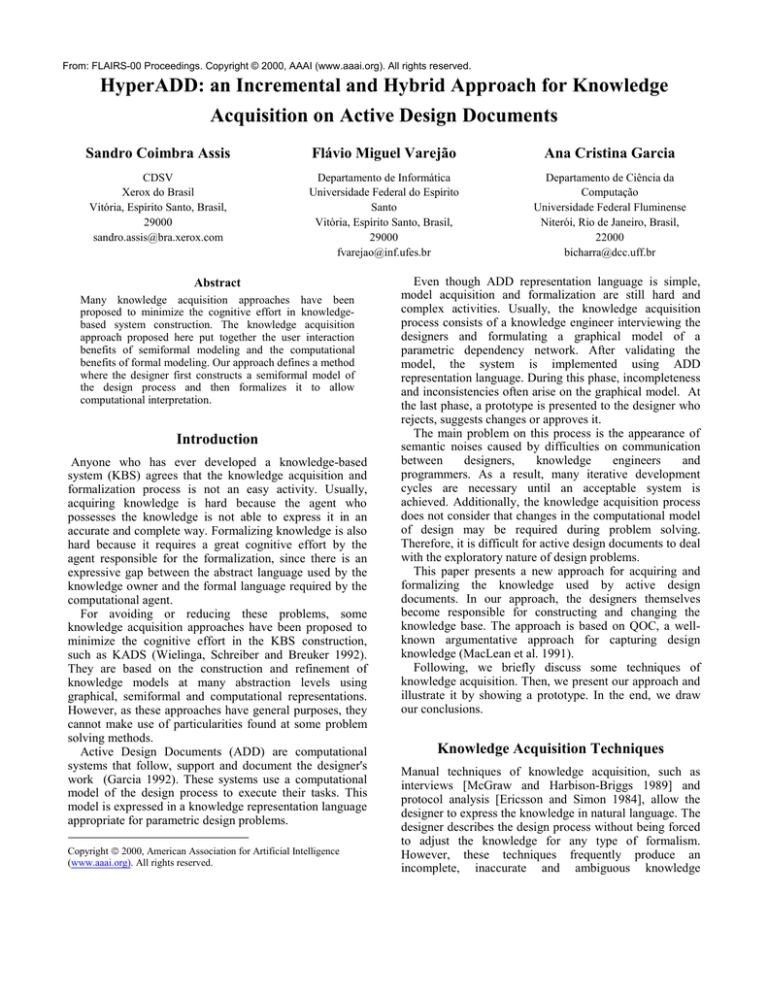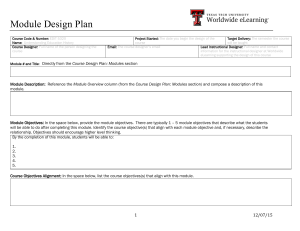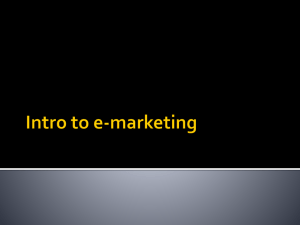
From: FLAIRS-00 Proceedings. Copyright © 2000, AAAI (www.aaai.org). All rights reserved.
HyperADD: an Incremental and Hybrid Approach for Knowledge
Acquisition on Active Design Documents
Sandro Coimbra Assis
Flávio Miguel Varejão
Ana Cristina Garcia
CDSV
Xerox do Brasil
Vitória, Espírito Santo, Brasil,
29000
sandro.assis@bra.xerox.com
Departamento de Informática
Universidade Federal do Espírito
Santo
Vitória, Espírito Santo, Brasil,
29000
fvarejao@inf.ufes.br
Departamento de Ciência da
Computação
Universidade Federal Fluminense
Niterói, Rio de Janeiro, Brasil,
22000
bicharra@dcc.uff.br
Abstract
Many knowledge acquisition approaches have been
proposed to minimize the cognitive effort in knowledgebased system construction. The knowledge acquisition
approach proposed here put together the user interaction
benefits of semiformal modeling and the computational
benefits of formal modeling. Our approach defines a method
where the designer first constructs a semiformal model of
the design process and then formalizes it to allow
computational interpretation.
Introduction
Anyone who has ever developed a knowledge-based
system (KBS) agrees that the knowledge acquisition and
formalization process is not an easy activity. Usually,
acquiring knowledge is hard because the agent who
possesses the knowledge is not able to express it in an
accurate and complete way. Formalizing knowledge is also
hard because it requires a great cognitive effort by the
agent responsible for the formalization, since there is an
expressive gap between the abstract language used by the
knowledge owner and the formal language required by the
computational agent.
For avoiding or reducing these problems, some
knowledge acquisition approaches have been proposed to
minimize the cognitive effort in the KBS construction,
such as KADS (Wielinga, Schreiber and Breuker 1992).
They are based on the construction and refinement of
knowledge models at many abstraction levels using
graphical, semiformal and computational representations.
However, as these approaches have general purposes, they
cannot make use of particularities found at some problem
solving methods.
Active Design Documents (ADD) are computational
systems that follow, support and document the designer's
work (Garcia 1992). These systems use a computational
model of the design process to execute their tasks. This
model is expressed in a knowledge representation language
appropriate for parametric design problems.
Copyright ã 2000, American Association for Artificial Intelligence
(www.aaai.org). All rights reserved.
Even though ADD representation language is simple,
model acquisition and formalization are still hard and
complex activities. Usually, the knowledge acquisition
process consists of a knowledge engineer interviewing the
designers and formulating a graphical model of a
parametric dependency network. After validating the
model, the system is implemented using ADD
representation language. During this phase, incompleteness
and inconsistencies often arise on the graphical model. At
the last phase, a prototype is presented to the designer who
rejects, suggests changes or approves it.
The main problem on this process is the appearance of
semantic noises caused by difficulties on communication
between
designers,
knowledge
engineers
and
programmers. As a result, many iterative development
cycles are necessary until an acceptable system is
achieved. Additionally, the knowledge acquisition process
does not consider that changes in the computational model
of design may be required during problem solving.
Therefore, it is difficult for active design documents to deal
with the exploratory nature of design problems.
This paper presents a new approach for acquiring and
formalizing the knowledge used by active design
documents. In our approach, the designers themselves
become responsible for constructing and changing the
knowledge base. The approach is based on QOC, a wellknown argumentative approach for capturing design
knowledge (MacLean et al. 1991).
Following, we briefly discuss some techniques of
knowledge acquisition. Then, we present our approach and
illustrate it by showing a prototype. In the end, we draw
our conclusions.
Knowledge Acquisition Techniques
Manual techniques of knowledge acquisition, such as
interviews [McGraw and Harbison-Briggs 1989] and
protocol analysis [Ericsson and Simon 1984], allow the
designer to express the knowledge in natural language. The
designer describes the design process without being forced
to adjust the knowledge for any type of formalism.
However, these techniques frequently produce an
incomplete, inaccurate and ambiguous knowledge
description. Thus, the reduced effort made by the expert
makes knowledge formalization hard, since the knowledge
engineer must interpret, complete and refine the knowledge
expressed by the expert.
Design knowledge acquisition techniques based on
hypertext (Conklin and Begeman 1989) assist the designer
to produce organized knowledge descriptions because
nodes and links represent categories of design concepts.
Therefore, it induces the designer to provide more accurate
and complete design knowledge. For instance, QOC
(MacLean et al. 1991) uses a semiformal representation for
guiding the designer in a systematic exploration of design
questions. However, QOC does not provide an operational
knowledge model for the design process. Therefore, it still
requires the knowledge engineer services. Moreover, QOC
does not provide active computational services for
supporting the knowledge engineer. For instance,
conflicting design decisions can only be identified by
browsing the hypertext documentation.
Knowledge based shells, such as Kappa1, require that
the designer express the design knowledge directly in a
formal language. This may restrict the deliberation process
and obstruct the knowledge acquisition. Some important
aspects of the design may be discarded just because it is
difficult for the designer to express them using the formal
language (Shum 1997).
The HyperADD Approach for Knowledge
Acquisition on Active Design Documents
In this section we present an incremental and hybrid
approach for knowledge acquisition on active design
documents. Our approach is incremental because the
designer first describes the knowledge (by using a QOC
based hypertext system), then formalizes it (by using a
high level interface for the ADD representation language)
and finally tries the new design process model. Our
approach is hybrid because it integrates semiformal and
formal representations. The integration of these
representations allows the designer to express the
knowledge using natural language and formalize it as a
computational model without requiring the intervention of
a knowledge engineer.
Computational models cannot anticipate all aspects
involved in the design process due to the design
exploratory nature. Opportunistic situations will demand
improvements at the computational model during design
problem solving. The designer, who detects these
situations, should make the adjustments in an interactive
way, as suggested by (Cartwright 1997). This interactivity
is achieved in HyperADD approach because the designer
can modify the computational model during the design
process. The ADD interface is automatically adapted for
the new model.
1 http://www.intellicorp.com
The Argumentative Process
In our approach, before formalizing the design knowledge,
the designer semiformally describes what he/she wants to
formalize. The QOC based semiformal structure induces
the designer to reflect about the design issues. We believe
that this argumentative process will subsidize the
formalization process. For semiformally describing the
design process, the designer uses some categories of design
concepts and relationships. Figure 1 shows a UML
graphical representation for the conceptual and
navigational scheme of our approach. These concepts and
relationships organize the designer's argumentation. The
designer may describe the concepts in natural language by
specifying their "description" attribute.
The question class represents the design parameters.
There are three specializations of this class: requirement
specification question, calculus question and decision
question. Each specialization has a different way of being
resolved. A requirement specification question does not
depend on any other design question. It is defined by the
external environment, by the user or by the own designer.
A calculus question is determined by the application of a
mathematical function or a heuristic rule to the values of
the questions upon which it is directly dependent. A
decision question evaluates a set of options by analyzing
restrictions and criteria. It indirectly depends on other
design questions. Typically, the option that satisfies all the
restrictions and optimizes the criteria will be chosen.
Restriction
Labe
Descrip tion
A uthor
S ource
constrains
Op tion E valuat ion
Decision
0. .*
1..* Final E valuation
Criteria E valuation
Restriction Evaluation
A nsw er
evaluate
Utility Function()
Criterion
Utility Function()
Label
Description 0. .*
A uthor
condit ion
1..*
is alternative to
Question
argum ent
1. .*
L abel
Description
A ut hor
Calculus
1. .*
Option
consequent
1..*
Label
Description
A uthor
Criterion E valuation
E valuation
V alue
0..*
A nswer
dependent
1..*
0..*
Form ula()
Restriction E valuation
Property
Requirem ent
Answer
Label
V alue
Evaluation
Value
Figure 1 - Conceptual Scheme
The order in which the questions are solved is established
by the "argument" and "condition" relationships. The
"argument" relationship determines which are the
arguments of a calculus question. The "condition"
relationship determines which are the questions used by the
set of decision criteria and restrictions. A dependency may
also be established by the "consequent" relationship
between an option and a question. This relationship means
that choosing one option implies the need for solving a
consequent question.
Criteria and restrictions assess the set of options of the
decision question. The "evaluates" relationship between a
criterion and a set of options establishes that they will be
evaluated according to this criterion. The "constrains"
relationship between a restriction and a set of options
qualifies each option as viable or not, according to the
restriction.
Models QOC may be represented graphically by a
graph, which makes easier the visualization but brings an
additional effort to organize the layout. In our approach
we chose to represent the argumentation as a hypertext. For
supplying the lack of visualization, we defined
navigational structures that aid the argumentation
construction and reading. These structures are represented
by the nodes and links on the conceptual scheme (figure 1).
The nodes represent the designer's possible visions and the
links represent the possible directions of navigation.
The conceptual scheme is navigated to assist the needs
of the knowledge acquisition. One user of the navigational
structures is the design process model constructor. This
designer needs to navigate on the computational model as
well as refine it incrementally. Another user is the designer
that uses the ADD model for designing. This designer
needs to input parameters values, ask for suggestions and
explanations, and navigate the design process model.
The "question" node presents information about the
question as well as the links tied up to the node. These
links connect the question with local information such as,
its options, criteria, restrictions and the questions that
depend on it. The user may also consult how the set of
options is evaluated.
The user is free to navigate through the questions
network by the "dependent", "argument" and "condition"
links. These links produce a local movement on the
network. Global movements are made through the main
menu or using the navigated questions history.
Figure 2 shows the hypertext page of a question that
selects a case from a database. The right frame shows the
contents of the visited question and the navigational links
classes. The left frame shows the navigational links
instances. One of the bottom frames shows the history of
the visited questions.
The Formalization Process
By defining the set of design questions and the relations
between them, the designer determines the order in which
the design parameters are evaluated. However, the designer
still needs to specify how each question should be
computed. The HyperADD interface allows the designer to
formalize the knowledge in a higher level representation
than the ADD language formalism. In this section, we
show how the design process model is formalized.
In a calculus question, the designer writes a formula that
defines the question using its arguments. A formula is an
expression written in the symbolic processing language
Lua (Ierusalimschy and Celes 1995). The expression
operands are the questions related to the calculus question
by the "argument " relationship. The operators are
arithmetic, relational, logical or catenated. The expression
may also contain calls to functions encoded in Lua.
Figure 2 - Decision Question
Figure 3. Utility Function
Values must be assigned to the options properties to
evaluate the options. The user browses the set of options
and chooses a property. For each property, a value matrix
is edited. Alternatively, the acquisition of options may be
automated through the use of an external source, such as a
database, or by defining the interval of values that certain
attributes may have. In both cases, the number of generated
options may be large. Such situations demand heuristic
search to find the best option.
Criteria and restrictions may be related to a pattern. In
our example, both criteria require that the options are close
to the Temperature Difference and Pressure Difference
patterns (figure 3).
The designer should write a utility function to specify a
decision question. A criterion weight defines its degree of
importance. The utility function uses them to balance the
multiple criteria. The utility function is also an expression
written in Lua. Figure 3 also shows how to acquire a utility
function for evaluating the "DesignCase".
Experimentation Process
Figure 4 shows the design interface automatically
generated by our knowledge acquisition tool. We offer this
capability to eliminate the need of intervention in the
generation of the ADD system by a knowledge engineer or
a programmer. Thus, the designer can experiment the
computational model and refine it until it attends the
designer's needs. In the interface, two button exists for
each question: the button "Calculate" asks the ADD system
to calculate and suggest an answer to the question and the
button "Explain" provides an explanation about the way
the question was resolved.
Conclusions
In this paper, we have proposed an argumentative approach
for knowledge acquisition on ADD systems. Designers are
required to
• deliberate about how the design process should be
executed. During the deliberation process they must
construct an argumentation. An hypertext based
approach instigates the designer's reflection and makes
easier the navigation and revision of the knowledge
description. The product of this activity is a
semiformal model of the design process.
• formalize the design process using a high level interface
for the ADD representation language. This interface
reduces the need of codifying the knowledge directly
on this formal language. The product from this activity
is a computational model for the active design
document.
Our approach lets the designer free for choosing the best
moment to formalize the knowledge. In other words, the
designer first builds the relations among the design
questions, criteria, restrictions and options and later, details
them by specifying formulas, heuristic rules and values of
properties.
Our approach lets the designer on the control over every
modeling phase: conceptualization, formalization and
experimentation. As the designer uses the computational
model and detects a situation that requires changes on the
model, he/she can easily modify and adapt it. As a
consequence, the resultant ADD system will be able to
cope with the exploratory nature of design problems.
Figure 4. Design Interface
We expect that the integration of argumentation and
formalization will produce the following benefits:
• Induce the designer's reflection about different design
alternatives and processes. This is achieved by the use
of the QOC argumentative structure.
• Make easier the modeling process since the design
model evolves from the semiformal to the formal level.
Therefore, our approach may avoid restricting and
hampering the reasoning whereas these situations often
arise when expressing the knowledge directly in a
formal representation.
• Allow the formalization in a more abstract level than
the one of ADD programming language. This is
achieved by providing computational services that aid
the generation of the ADD computational model.
We have not constructed a complete ADD system using
HyperADD yet. Indeed, we have only constructed part of
an active design document system for the design of process
plants of oil plataforms. Our evaluation is that HyperADD
makes easier the construction of ADD systems than the old
approach. However, it was a knowledge engineer that used
HyperADD for constructing the system. It will be
necessary that a designer use it for a better evaluation.
There are some topics for future research. We have
implemented a blind search strategy to evaluate decision
questions. We need to extend the prototype by including
new heuristic search strategies. We have also based our
argumentation process in QOC, which is a simple notation.
But there are more expressive notations, for instance,
SYBIL (Lee 1990).
References
Cartwright, A.J. 1997. Interactive Prototyping - A
Challenge for Computer Based Design. Research in
Engineering Design 9(1):10-19.
Conklin, J.; and Begeman, H.L. 1989. gIBIS: A Tool for
All Reasons. Journal of the American Society for
Information Science, May, 200-213.
Garcia, A.C. 1992. Active Design Documents: A New
Approach for Supporting Documentation in Preliminary
Routine Design. Ph.D. diss., Dept. of Civil Engineering,
Stanford University.
Ericsson, K.A; and Simon, H.A. 1984. Protocol Analysis,
Verbal Reports and Data. Cambridge, Mass.: MIT Press.
Ierusalimschy, R.; and Celes, W. 1995. Reference manual
of the programming language Lua 2.1. Monografias em
Ciência da Computação, Departamento de Informática,
PUC University, Rio, Brazil.
Lee, J. 1990. SIBYL: A Qualitative Decision Management
System. In P.H. Winston & S. Shellard (Eds.). Artificial
intelligence at MIT: Expanding frontiers, 104-133.
Cambridge, MA: MIT Press.
McGraw, K.L, and Harbison-Briggs, B.K eds. 1989.
Knowledge Acquisition, Principles and Guidelines.
Englewood Cliffs, N.J.: Prentice-Hall.
MacLean, A.; Young, R.; Bellotti, V.; and Moran, T. 1991.
Questions, Options and Criteria: Elements of a Design
Rationale for User Interfaces. Human-Computer
Interaction, 6:201-250.
Shum, S. B. 1997. Balancing Formality with Informality:
User-Centred Requirements for Knowledge Managements
Technologies. In Proceedings of the AAAI Spring
Symposium on Artificial Intelligence in Knowledge
Manegement, 22-26, Stanford University, Palo Alto, CA,
AAAI Press.
Wielinga, B.J.; Schreiber, A.T. and Breuker, J.A. 1992.
KADS: A modelling approach to knowledge engineering,
Readings in Knowledge Acquisition and Learning, 92-116,
Morgan Kaufman Publishers.




